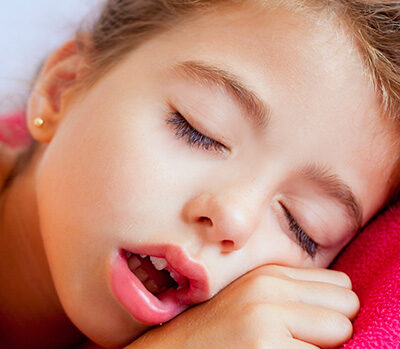The way your child breathes during sleep impacts on their health and development. Snoring, sleep apnea and episodes of increased resistance in the upper airways during sleep can contribute to symptoms such as behavioural difficulties, hyperactivity, irritability, bed-wetting, morning headaches, excess sleepiness and obesity.
About 1 in 10 children are thought to have some type of sleep disordered breathing and 3% have the most severe form called sleep apnea, where breathing stops repeatedly during sleep (1).
What to look for in your child to see if they have sleep disordered breathing:
Sleep behaviours
- Snoring
- Mouth breathing during sleep
- Drooling on pillow
- Excessive restlessness
- Bed wetting
- Tooth grinding
- Difficulty falling asleep, sleep avoidance
- Increased respiratory effort during sleep
- Stomach or chest sucking in during the in-breath
Daytime behaviours
- Excessive fatigue and sleepiness
- Behavioral difficulties
- Hyperactivity
- Poor attention
- Poor concentration in school
- Irritability
Other symptoms
- Obesity
- Morning headaches
- Slow growth and failure to thrive
- Sugar cravings
If you suspect your child has sleep disordered breathing or sleep apnea, you should ask your doctor if they would recommend a sleep study.

How can you help your child improve their sleep and breathing?
For some children, the first step to improving sleep disordered breathing is removal of adenoids and tonsils. It may also be necessary to get allergies under control. Children with severe sleep apnea may be advised to use a CPAP machine.
The following steps should also be considered:
Stop mouth breathing
- Mouth breathing affects the health, stability and tone of the upper airway. It leads to snoring and contributes to sleep apnea. Up to 50% of children may continue mouth breathing after removal of adenoids and tonsils. This can reduce potential benefits and effectiveness of the surgery in correcting sleep disordered breathing.
Improve the size and function of the airway
- Abnormal tongue rest posture, poor muscle tone of the oral muscles, abnormal swallowing pattern and weak lip seal contribute can reduce the size and affect the function of the airway
- Breathing exercise and orormyofacial exercises that improving the muscles tone of the throat and back of the tongue can help to improve the operating size and function of the upper airways.
Correct dysfunctional breathing
- Poor breathing patterns, uexplained breathlessness and abnormal function of breathing muscles such as the diaphragm can be caused by and contribute to sleep disordered breathing. Some children can also develop chronically low oxygen levels and abnormal carbon dioxide levels. These can often be corrected with the right sort of breathing retraining.
The Healthy Breathing, Healthy Child program can be a useful part of an overall treatment plan for children with snorning and sleep apnea.
Reference:
- Guilleminault C, Pelayo R. Sleep-disordered breathing in children. Annals of Medicine. 1998;30(4):350-6.
